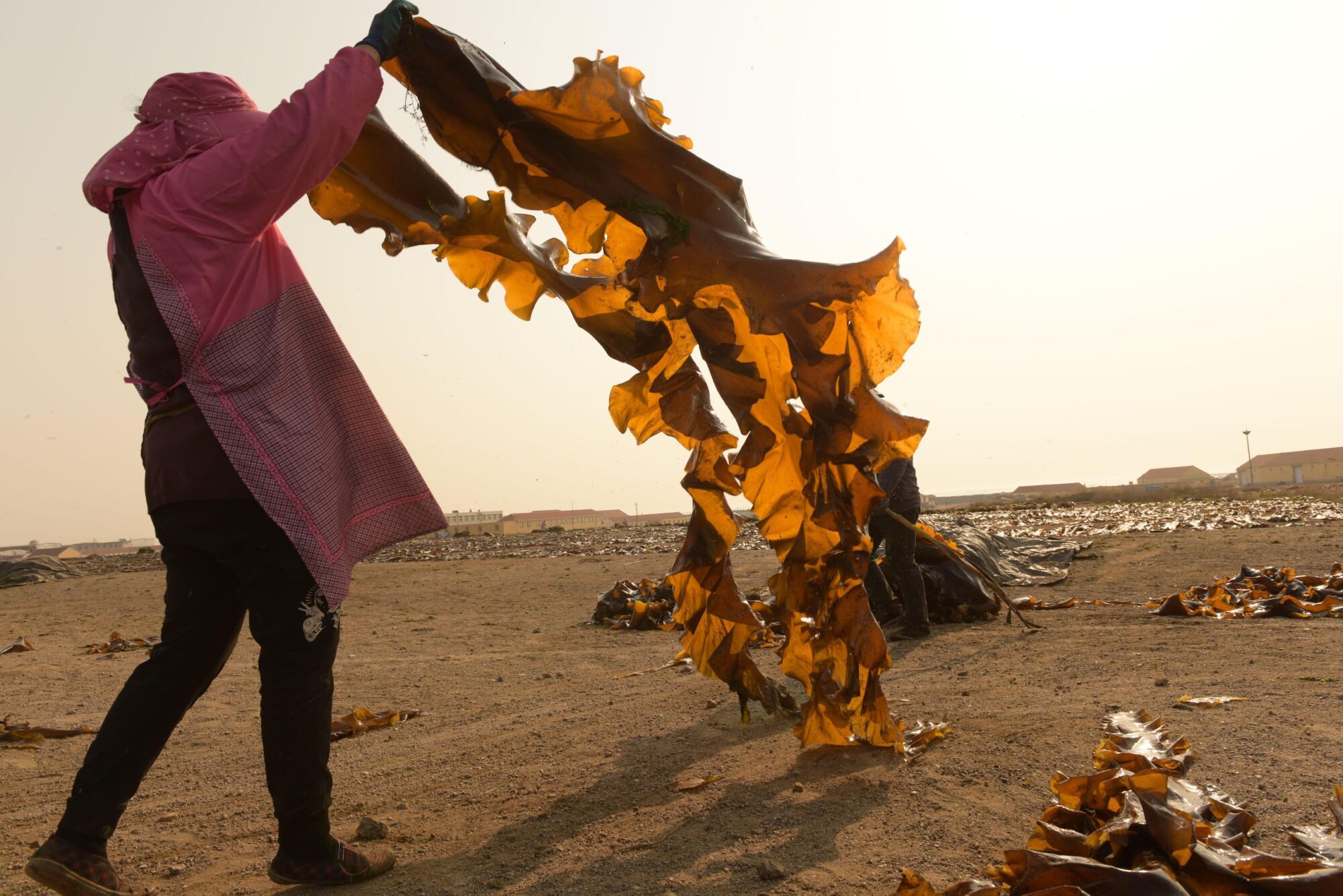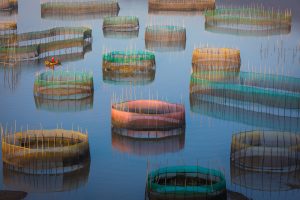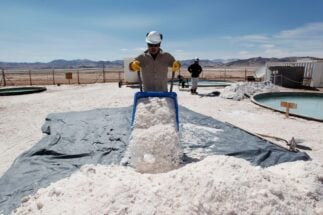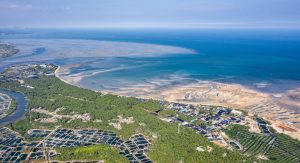Managing the climate crisis will require more than a rapid cut in carbon emissions in the coming decades. We must also remove some CO2 from the atmosphere and store it long-term. ‘Blue carbon’ refers to the carbon stored in coastal and marine ecosystems. Its focus has largely been on coastal areas such as mangrove swamps, salt marshes and seagrass meadows, given their accessibility and important role not just in mitigating climate change but in protecting coastlines and providing healthy fisheries.
China’s blue carbon policy-making has largely focused on coastal areas too. National projects to restore wetlands started in 2016, concentrating on mangroves in the south and tamarisks in the north. Last year, a national five-year action plan was launched for mangrove swamp restoration. The government also committed to restore coastal ecologies in its broader plans for important ecosystems. In April this year, an expanse of mangrove swamp in Zhanjiang became the foundation for China’s first blue carbon credit project.
However, some researchers are looking beyond coastal areas to the blue carbon potential of deeper waters. Recent research shows that marine animals from krill to whales capture carbon and store it in the ocean. A much-discussed research paper, published last year, found that reducing fishing and allowing populations to rebuild would sequester carbon in living biomass and also when carcasses fall to the ocean floor.
China is looking beyond coastal blue carbon, too. In July, Wang Hong, head of the State Oceanic Administration (SOA), said at a press conference that plans for trading blue carbon would focus on both coastal ecosystems and novel approaches such as “fishery carbon sinks” and “microbial carbon pumps”. Wang noted “huge potential in these areas”. But what do they mean and how can they store carbon?
What is a ‘carbon sink fishery’?
Tang Qisheng, an ocean fisheries and ecologies expert, and a member of the Chinese Academy of Engineering, coined the term “carbon sink fishery” in 2010. He was inspired by an international experiment that fertilised an area of ocean with iron to sequester CO2 from the atmosphere by promoting the growth of phytoplankton.
Tang realised that any type of fishery that doesn’t require extra feed inputs could be used to sequester carbon. Seaweeds (macroalgae) and shellfish farming are the easiest options because they rely on photosynthesis and filter feeding, respectively. While the carbon within a harvested product, such as a shellfish, is broken down and re-released into the atmosphere, at least some of it remains sequestered in the ocean. In 2017, Tang said the carbon removal contribution of China’s mariculture of seaweeds and shellfish is equivalent to over 700,000 hectares of forest planting every year. That’s also the equivalent of the area of China’s rainforest protected by its ecological redlines policies.
Tang thinks the carbon sink fishery idea could also be expanded to fish, cephalopods, crustaceans and echinoderms such as sea cucumbers, and that fishing could be included too. He suggests using ocean food chains to build a vertical aquaculture system: kelps, scallops and sea cucumbers bred at varying depths, making use of each other’s metabolites, forming an efficient form of carbon sink. He also suggests using artificial reefs and technology to control fish shoals to keep bred and released fish gathered in one place, with nearby seagrass and kelp beds. This would increase aquaculture output and blue carbon, he says. Tang estimates that mariculture in China could store over four million tonnes of carbon by 2050. He suggests the approach would derive profits from both seafood sales and carbon trading.

Some coastal provinces are interested. Qingdao established China’s first carbon sink fishing laboratory in 2011, and the city’s Development Zone has designated carbon sink fisheries as “a new route for developing the ocean fishery economy”. In April, Weihai, another city in Shandong, published a 2021-2025 action plan for blue carbon development that mentioned the creation of carbon sink standards and plans for carbon trading. In August, Xiamen set up a blue carbon trading services platform to promote standards for blue carbon sinks, including in fisheries.
Are carbon sink fisheries possible?
The fishing industry catches seafood for people to eat, or for use as feed and industrial raw materials. During those processes, organic matter is broken down, with carbon released to the atmosphere as CO2 or methane. So how would carbon sink fisheries store carbon?
They would focus on shellfish and commercially farmed seaweeds, primarily kelp, wakame and nori. Shellfish absorb CO2 to grow shells of calcium carbonate, a process that stores carbon. Seaweeds also absorb carbon as they grow and at the same time release two less tangible forms of carbon, particulate organic carbon (POC) and dissolved organic carbon (DOC). The former ends up in coastal sediment while the latter is widely dispersed in seawater. Both can be stored for long periods. This process of absorbing non-organic carbon and releasing organic, stable forms is termed a “biological carbon pump”.
A 2017 literature review of carbon sequestration mechanisms in China’s coastal mariculture found that POC and DOC actually accounted for the majority of the carbon stored by seaweeds. Even if seaweeds are harvested and utilised, the review found that most of the carbon they sequester remains in the ocean. However, the IPCC (Intergovernmental Panel on Climate Change) has found “large uncertainties relating to sequestration duration and effectiveness”.
At present, the contribution of shellfish to the carbon cycle is not understood
The review points out that shellfish also emit CO2 through respiration and calcification, the process of growing a shell, and so their carbon sequestration potential remains disputed. While shellfish produce large amounts of DOC, it is easily utilised by microorganisms and released as CO2. Therefore, the authors concluded that “at present, the contribution of shellfish to the carbon cycle is not understood”.
When it comes to fishing, according to a 2016 paper by Tang Qisheng, increasing fish populations, by methods such as marine ranching or restoring seagrass meadows, would also promote the biological storage of carbon. This assumes that the carbon absorbed by growing fish is derived from phytoplankton and that no extra feed is given.
The key to carbon sink fishing is to increase fish populations. Tang proposes releasing fish bred in captivity and using fishing quotas to avoid the negative carbon impacts of overfishing. Unlike some researchers, who want to cut back on fishing and allow fish to grow and die naturally in order to increase carbon storage, Tang thinks a carbon sink fishing approach could create a resource-conserving fishing industry which “will enable a modern fishing industry to develop rapidly and more sustainably”.
However, Tang doesn’t address the question of what happens to the fish once they’ve been caught. How should we account for the emissions incurred during transportation, processing, consumption and waste? Would a carbon sink fishery still effectively sequester carbon once those processes are taken into account?
The idea of carbon sink fisheries has been around for over a decade, but many challenges to its implementation remain. At an academic conference in early September, an official with the Ministry of Agriculture said: “There’s no systematic theory, models, standards or accounting methods for carbon sink fisheries, and tech breakthroughs and improvements are still needed.”
Internationally, concerns have been raised about the challenge of measuring, reporting and verifying blue carbon. A 2017 brief by Climate Analytics pointed out that carbon flows in coastal environments are highly variable and hard to measure, and carbon sequestration there may even be reversed by the impacts of climate change. That brief focused on coasts, but the same is true for deeper waters. For example, in March this year Jiaozhou Bay in Shandong saw an outbreak of sea stars, which ate huge expanses of farmed shellfish. Such events present a challenge to the management of a carbon sink fishery and the measurement of sequestered carbon.
What is a ‘microbial carbon pump’?
The microbial carbon pump that SOA chief Wang Hong referred to is a concept developed by Jiao Nianzhi, a member of the Chinese Academy of Sciences and a professor at Xiamen University’s College of Ocean and Earth Sciences. The idea has had a major impact on international understanding of the potential of ocean carbon sequestration and broadened the definition of blue carbon.
There is about 20 times as much dissolved organic carbon as there is particulate organic carbon in the ocean. Of the DOC, 95% is “recalcitrant”, meaning it can persist in the ocean for 4,000-6,000 years. The remainder is “labile”, which means it is easily broken down by organisms. Recalcitrant DOC represents a vast store of carbon in the ocean, equivalent to all atmospheric carbon. Expanding that store would provide a route to increasing the ocean’s carbon sequestration.
Scientists have long been aware of recalcitrant DOC but were unsure how it was formed. There was speculation it came from seabed seepage of organics, but research ruled that out. Jiao and other researchers found that it is formed by microorganisms, which transform labile DOC into the recalcitrant form. The process is efficient and the quantities involved are, thanks to the huge numbers of microorganisms in the ocean, jaw-dropping. They termed these mechanisms “microbial carbon pumps”.
Once Jiao and colleagues understood where that vast and stable store of carbon came from, they proposed two ways to consolidate and expand it. Both aim to increase the efficiency of microbial carbon pumps by managing eutrophication – an excess of nutrients – in coastal waters. Excessive nutrients cause microbial carbon pumps to slow and emit more greenhouse gases.
The first approach is land–sea integrated pollutants reduction. It tackles nutrient pollution in the ocean by controlling fertiliser use on land and through other measures. The second is to create “artificial upwelling” in aquaculture zones using clean energy to pump eutrophic water from the seabed up to the surface where the nutrients can be consumed by farmed organisms. This would, the theory goes, increase both carbon storage in aquaculture and the efficiency of carbon pumps. An additional benefit would be the steady circulation of excess nutrients, rather than them being stirred up all at once when storms hit, which can cause algal blooms and potentially also sea star outbreaks.
However, the IPCC’s special report on the ocean and cryosphere, published in 2019, finds that the benefits of land-based nutrient approaches “have yet to be determined quantitatively and uncertainties remain regarding the longevity of removal”. The report described artificial upwelling as a possible climate change adaptation method but did not assess its potential for carbon sequestration.
In addition to the two proposals discussed, Jiao has also called for the addition of alkaline materials in acidified and oxygen-poor areas of the ocean to sequester large quantities of carbon. Alkaline compounds react with excess CO2 in seawater to form mineral bicarbonate. Ocean alkalisation is generally regarded as a CO2 removal technique, rather than an enhancement of a carbon sink. The IPCC notes that ocean alkalisation “would have governance challenges, with the increased risk of undesirable ecological consequences”.
It remains to be seen whether these novel blue carbon approaches will be viable solutions to managing the climate crisis
Jiao argues that while coastal ecosystems such as mangrove swamps may be more visible, their actual climate change mitigation potential is limited. The IPCC says mangroves can likely offset less than 2% of current emissions. “They can’t do much about climate change other than providing ecosystem services,” Jiao wrote.
Jiao thinks the three “ocean negative emissions techniques” would support China’s carbon neutrality goal, although if these ambitious proposals were to be adopted then international cross-disciplinary cooperation would be needed to develop measuring technology, assessment methodologies and standardisation schemes. To this end, he and other Chinese scientists have established the Ocean Negative Carbon Emissions International Scientific Plan (ONCE), which he hopes will produce a China-led set of standards for blue carbon and negative emissions, “providing a Chinese solution for global governance”.
He is also aware of the potential for blue carbon to increase China’s international influence. Five years ago, at a Two Sessions meeting, Tang (who is a People’s Representative) proposed exporting blue carbon technologies to nations signed up to the Belt and Road Initiative.
In late August this year, the Ministry of Ecology and Environment said it would explore “new models of ocean ecological restoration which centre on boosting climate resilience and increasing blue carbon sinks”. China is due to publish its first Five Year Plan for protection of the ocean environment this year, and blue carbon is expected to feature. It remains to be seen how China will implement these novel blue carbon approaches and whether they will be viable solutions to managing the climate crisis.









